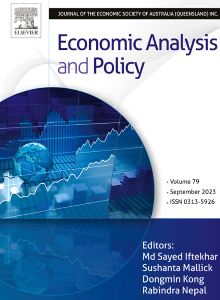女性议价能力与家庭支出:来自中国微观数据的非线性效应
IF 8.7
2区 经济学
Q1 ECONOMICS
引用次数: 0
摘要
本研究探讨女性在中国家庭中的议价能力如何影响家庭支出模式。利用2017年和2019年中国家庭金融调查(CHFS)的44147个家庭(包括一对合法结婚的夫妇)的微观数据,我们采用了一个结合广义倾向得分匹配(GPSM)的集体家庭模型来估计因果关系。分析揭示了一个显著的非线性(倒u形)关系:家庭支出随着女性议价能力的提高而增加,当妻子贡献约占配偶总收入的50%时达到峰值(即议价能力值约为0.5),然后在此之后下降。我们进一步确定了亚组之间的实质性异质性,在城市、中等收入、年轻家庭以及与岳父母同住的家庭中观察到的影响最强。值得注意的是,女性议价能力的增强增加了妻子的个人支出,同时减少了丈夫的支出。通过将中国的制度和文化特征整合到家庭内部议价框架中,本研究丰富了对家庭经济行为的理解,并为促进家庭福利和推进性别平等改革提供了实用的政策见解。本文章由计算机程序翻译,如有差异,请以英文原文为准。
Women’s bargaining power and household expenditure: Nonlinear effects from Chinese microdata
This study examines how women’s bargaining power within Chinese households affects household expenditure patterns. Using microdata from 44,147 households that include a legally married couple from the 2017 and 2019 waves of the China Household Finance Survey (CHFS), we apply a collective household model combined with Generalized Propensity Score Matching (GPSM) to estimate causal effects. The analysis reveals a significant nonlinear (inverted U-shaped) relationship: household expenditure increases as women’s bargaining power rises, peaking when the wife contributes approximately 50 % of the total spousal income (i.e., a bargaining power value of ∼0.5), and then declines beyond that point. We further identify substantial heterogeneity across subgroups, with the strongest effects observed among urban, middle-income, and younger households, as well as those living with the wife’s parents. Notably, greater female bargaining power increases wives’ personal expenditures while reducing husbands’ spending. By integrating Chinese institutional and cultural characteristics into an intra-household bargaining framework, this study enriches the understanding of household economic behavior and offers practical policy insights for promoting household welfare and advancing gender-equitable reforms.
求助全文
通过发布文献求助,成功后即可免费获取论文全文。
去求助
来源期刊

Economic Analysis and Policy
ECONOMICS-
CiteScore
9.80
自引率
9.20%
发文量
231
审稿时长
93 days
期刊介绍:
Economic Analysis and Policy (established 1970) publishes articles from all branches of economics with a particular focus on research, theoretical and applied, which has strong policy relevance. The journal also publishes survey articles and empirical replications on key policy issues. Authors are expected to highlight the main insights in a non-technical introduction and in the conclusion.
 求助内容:
求助内容: 应助结果提醒方式:
应助结果提醒方式:


